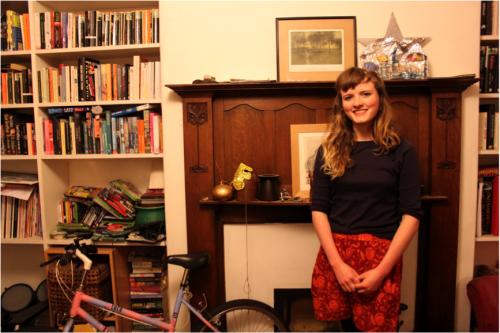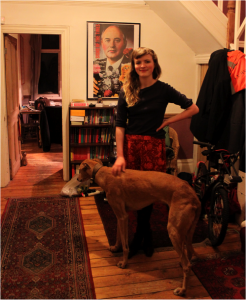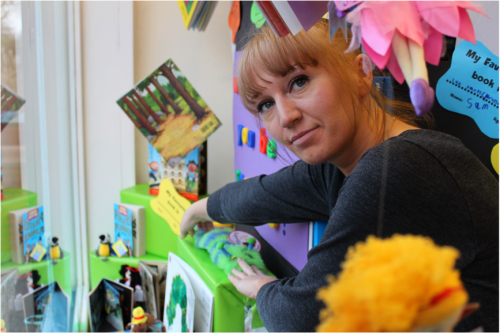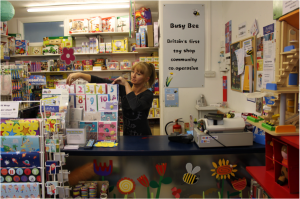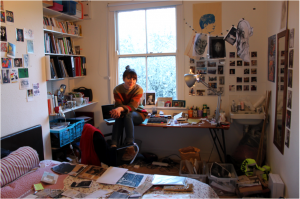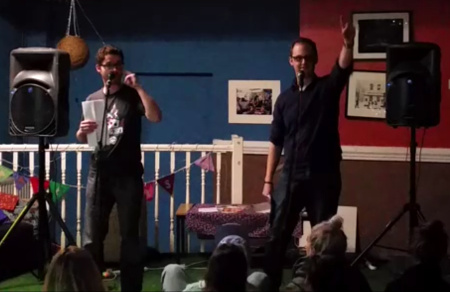Art foundation at a time of austerity
Article published: Tuesday, March 13th 2012
With jobs scarce and degrees increasingly judged by their potential for delivering graduates into well paid careers, arts students are coming under ever more pressure. MULE spoke to people who are currently doing art foundations, to find out why they chose to take on the course and whether their experiences met their expectations.
When in my final year at university, I logged onto the careers service. Servicing me with a career? Yes please. I typed in my search criteria: a full time job in “arts, medias and culture” anywhere in the UK.
“I’ll start broad”, I thought to myself optimistically, “and whittle it down as I go along”. I pressed enter and was met with the message “no results found”.
This has been the experience of many arts graduates, who have struggled to find work in their chosen field. As a result, demand for postgraduate studies has increased by as much as 7.4 percent from 2009 to 2010, as more people postpone potential unemployment. “Apparently, an MA is the new BA!” one of my university lecturers enthusiastically told me when I bumped into him after graduating.
At a time when increased University fees mean that courses are inevitably linked to the financial returns the student can expect to see upon graduation, the piece of paper given to you by someone in a silly hat is coming to mean more than the knowledge you gain.
The qualification students receive at the end of the year-long art foundation course can be derided as virtually worthless in the world of CVs and employment statistics. The Manchester School of Art describes its art foundation course as “a stimulating, creative and thought-provoking environment where students have the opportunity of exploit and understand a broad range of art and design activities”. There is a notable absence of talk of employability or remuneration.
So why, then, would some people choose to take on an art foundation? Here, three women who have undertaken the course explain what it means to them.
Kate Paul, 19, lives with her parents in Chorlton and started the course after completing her A Levels.
Although I had said in the past that I had wanted to work in the arts, I didn’t really take the option seriously. Doing an art foundation seemed to me more like a sensible precaution, just in case I regretted not having done it when I inevitably chose “something academic” for my degree.
I knew lots of people who had done an art foundation and not gone on to do art, and it seemed like an easy way to busy myself thoroughly as I waited for what I wanted to do to be made clear. The plan had been to stall for time, messing around with paint, cutting and sticking, playing with wire.
While that is almost exactly what I have been doing, I have a completely different perspective on the worth of an art foundation, or at least its worth for me. While what I want to do is still unclear, I know that I will have to do a lot more of trying things out. To me, that is now exciting, rather than terrifying.
Also, I am no longer having an in-joke with myself when I say, in response to “what do you want to do?” that I would like to work in art. I am now slightly clearer on what that might be; potentially illustration or theatre design.
I found that being around so many different people with different interests showed me the diversity of opportunities in the art world, which relaxed me and made me feel like I had more choice.
I didn’t immediately embrace the course, and I spent a while thinking that I had proved to myself that it wasn’t for me. It became clear, quite quickly, that I had to make what I was doing my own, and I had to find a way for it to interest me by myself, one of the main aims of the course being to encourage independence.
I am very happy that I chose to do it; I think it has been a very reassuring and useful thing to do.
Gemma Fone, 29, lives with her daughter in Northenden and is doing her second art foundation.
When I did my first art foundation course at 18 I wanted to go into illustration. After completing the course, I got into MMU to do an interactive arts degree. When I was in my second year I found out I was pregnant and decided to leave.
A few years on, I decided to go back to my studies and do another foundation course. I was extremely excited about learning different techniques; life drawing, photoshop, things like that. Initially I was a fulltime student, studying and working and with a young child to bring up on my own. I found it hard to keep up with the studying and the coursework, although I was enjoying the course itself.
I decided to do a second art foundation because, simply, I want to draw. If I got to university then that would just be a bonus. I struggled through and tried to do my best but I had no time for my daughter and that upset me, which in the end made me decide to go part time.
The part time course is a lot more relaxed but it’s at a new campus, which is in Moston. It’s quite a long drive from mine every morning and I don’t have the funds to pay quite a lot of petrol money out every week so it’s become a burden. I’m in a difficult situation, which has changed my view of the course- I don’t feel as easy with it as I had initially.
It is a shame that my situation has made me feel this way about the course, it is an amazing and artistically challenging course to be on, each brief is a different media from rough sketching to textiles, to print and photography. You get an amazingly wide range of experience with tutors who are incredible, extremely patient and understand your learning needs.
After speaking to Gemma about her experiences of the course, she emailed me to tell me she was thinking of leaving.
I am thinking of quitting art foundation and just drawing for a hobby and for other people. I’m in great need of money and have decided to do an NVQ in retail skills and management. I feel disappointed in myself but I couldn’t afford the art supplies and petrol every week.
It was a brilliant course but I just struggled with time and finances. I would have wanted to go into illustration or work with children doing arts and craft, but now I will continue to work in retail and draw in my spare time.
Sarah Hill, 21, started the course after graduating from the University of Manchester.
It was in my final year at university, knee deep in dissertation hell, that I woke up one morning and began writing applications for art foundation courses. At the time the future didn’t exist any further than my next essay deadline and the idea of being thrown out of my academic comfort zone into the ‘real world’ seemed unfathomable.
More than a year on, I recognize this sudden impulse as a true moment of clarity. Though I’ll confess I’ve felt insecure and confused about my decision at times, it has been one of the best I’ve ever made.
In many ways it was a mixture of regret and frustration that prompted me to apply. Visual art has always been important to me, and though I kept my interests as active as I could, I spent much of my degree wondering whether I would be better off at art school. As a result, I didn’t fully begin to enjoy my course until the last semester, just as it was coming to an end. Still, I felt wildly excited at the prospect of spending a year making things with my hands that had nothing to do with critical theory.
I also had nothing to lose other than more money. But even that felt like pittance in the grand scheme of things. I am continually astounded by the value for money of this course (which is free for those straight out of school) in comparison to my degree, for which students will now be paying 9,000 a year in exchange for around six contact hours a week while continually fighting for facilities.
Here, I have good quality materials at my disposal, access to workshops, technicians at hand and as much contact time as I desire with tutors who seem willing to bend over backwards. I am a strong believer that university will always be what you make of it, but to feel that my course genuinely cares about the individual makes all the difference.
My unusual choice to do an art foundation directly following my degree was, at least initially, met with a succession of raised eyebrows. Some tutors were more positive, yet, whether or not it was paranoia I always sensed that a foundation course was something no one really took seriously. Neither was it seen as particularly challenging. “It’ll be a lot of fun”, one told me with a shrug and a smile.
Fine Art Foundation is not only hugely enjoyably and fulfilling, but, with the right attitude, will open up numerous doors and push you to be more self-motivated. And best of all, it doesn’t feel like work – more like a year-long indulgence that also happens to be a legitimate educational qualification. I spend all my time experimenting with different media. More to the point, I spend all my time doing what I want.
Sometimes I see my daily existence for what it is: my best friend has a four year training contract with an American law firm, while I spend much of my time making paper collages. However, this happens to suit me down to the ground.
For me, foundation is a stepping-stone towards some sort of job in the visual arts. I’m interested in numerous things – curating, filmmaking, publishing – but don’t feel the time is right to pursue any definite ‘career’ path. As long as I’m somehow paying the bills, for the time being I’m happy to continue doing what I enjoy, seeking out opportunities and seeing where things take me.
Lucy Allan
More: Culture
Comments
No comments found
The comments are closed.

